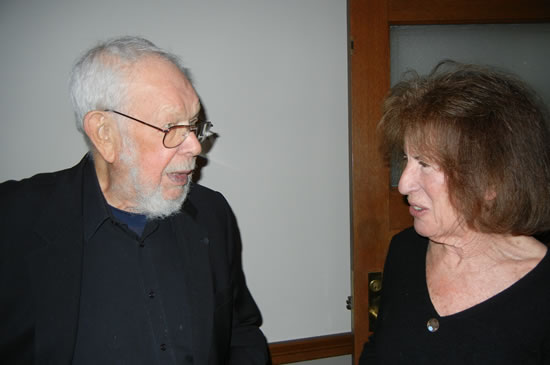MAD Magazine’s Al Jaffee Donates Work to Columbia U: Predecessor of the Graphic Novel
By Joan Baum, Ph.D.

(L-R) Al Jaffee & Joan Baum
The enthusiastic SRO crowd pressing out into the hall and perched on the window sills in Columbia University’s Rare Book and Manuscript Library came to pay tribute to MAD Magazine master writer and illustrator Al Jaffee. The overflow turnout —friends, colleagues and fans of all ages—for sure testified to the power and pervasiveness of graphic art today and to the prestige of 93-year-old Jaffee, a long-time MAD contributor whose archives have just been donated to the university. The event says something about the recognition of cartooning as an expression of American cultural history and as an example, in the hands of serious artists such as Jaffee, of finely honed technical skills put to the service of satire, now mostly served by TV and the Internet. Think Jon Stewart, National Lampoon, Stephen Colbert , SNL. MAD and Jaffee, an “icon of cartooning” Charles Schulz called him, got there first, in the `40s.
Certainly the graphic art genre got to librarian Karen Green when, a few years ago, acting on a life-long passion for comics, she segued from being a librarian for Ancient & Medieval History at Columbia to institute a Graphic Novel division at the university. She also made her presence felt at significant cartooning conferences, such as serving as a judge in 2011 for The Will Eisner Comic Industry Awards, referred to as the “Oscars” of the profession. Eisner, who died in 2005, was, like Jaffee, an alumnus of the first graduating class of the LaGuardia High School of Music & Art (then at 135th Street and Convent Avenue) and, later, a fellow MAD man. (Will “The Mad Playboy of Art” Eisner is not to be confused with Will “The Spirit” Elder, d. 2008, also of M & A and, also a much admired MAD man and Jaffee colleague.)
The evening belonged to Jaffee who sat with the assembled panelists — comic book writer and former DC Comics President Paul Levitz, who moderated the wonderfully immoderate couple of hours, caricature artist and MAD art director Sam Viviano, and “alternative cartoonist and illustrator” Peter Kuper. The evening also belonged to art -- a dying discipline in schools, it was noted, to judge by continuing cuts to arts programs in education budgets all over the country. How fortunate he was, Jaffee said in a perfectly articulated bass baritone, to have gone to Music & Art, a high school that specialized in art and that maintained high academic standards that inevitably attracted bright youngsters who not only had talent but wanted to say something about the temper of the times — mainly the “baloney” being sliced by hustlers out to sell bogus and unnecessary goods and ideas. With the possible exception of photography, it’s rare today that any art form lays bare the emperor without clothes. The satiric mantle now is worn mainly by stand up comics and talk show hosts, many of whom rely on f- and s-words. Jaffee deadpans: “Artists as a group are benign” (pause for guffaws), to which Viviano adds, it’s a snarky world, but Al has always been not just snarky but polite, using humor not vitriol to expose, not preach, stupidity and inanity. His satire was and is joyous-silly, among the more cherished features being, “Snappy Answers to Stupid Questions” and the MAD fold-in that surprises by showing innocuous scenes that, when collapsed toward center, turn into critiques. Jaffee skewered hypocrisy without partisanship, though it’s clear he’s no WASP. Indeed, he recalled The Depression, one of the 20th century’s defining moments, and how his parents were not thrilled with his choice of art as a profession, preferring that he take up a trade, but he was and remains adamant: “go for what you love.”
The materials bequeathed to Columbia, the first of several installments, contain original work (who thought then that originals mattered, Jaffee said) and show how he developed as an artist – moving from black and white to color. They also indirectly suggest early ambient influence, Rube Goldberg inventiveness, for example. As Kuper pointed out, the history of cartooning is important. Today, an age of instant, insular and in-your-face everything, artists don’t seem to care about who or what preceded them, but the best, Kuper implied, see themselves part of a tradition. And more. Certainly, Jaffee’s generous crediting of collaborators and colleagues, his humility as well as humanity, prompted at evening’s end a spontaneous standing ovation.#
